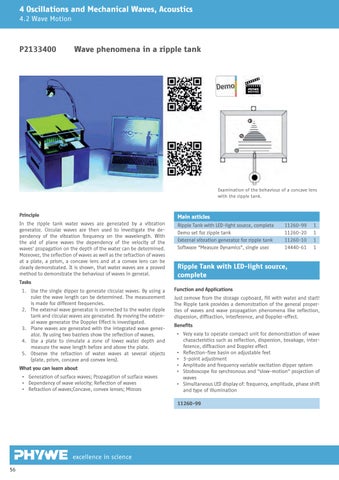4 Oscillations and Mechanical Waves, Acoustics 4.2 Wave Motion
P2133400
Wave phenomena in a ripple tank
Examination of the behaviour of a concave lens with the ripple tank.
Principle
Main articles
In the ripple tank water waves are generated by a vibration generator. Circular waves are then used to investigate the dependency of the vibration frequency on the wavelength. With the aid of plane waves the dependency of the velocity of the waves' propagation on the depth of the water can be determined. Moreover, the reflection of waves as well as the refraction of waves at a plate, a prism, a concave lens and at a convex lens can be clearly demonstrated. It is shown, that water waves are a proved method to demonstrate the behaviour of waves in general.
Ripple Tank with LED-light source, complete Demo set for ripple tank External vibration generator for ripple tank Software "Measure Dynamics", single user
11260-99 11260-20 11260-10 14440-61
1 1 1 1
Ripple Tank with LED-light source, complete
Tasks 1. Use the single dipper to generate circular waves. By using a ruler the wave length can be determined. The measurement is made for different frequencies. 2. The external wave generator is connected to the water ripple tank and circular waves are generated. By moving the external wave generator the Doppler Effect is investigated. 3. Plane waves are generated with the integrated wave generator. By using two barriers show the reflection of waves. 4. Use a plate to simulate a zone of lower water depth and measure the wave length before and above the plate. 5. Observe the refraction of water waves at several objects (plate, prism, concave and convex lens). What you can learn about ▪ Generation of surface waves; Propagation of surface waves ▪ Dependency of wave velocity; Reflection of waves ▪ Refraction of waves;Concave, convex lenses; Mirrors
Function and Applications Just remove from the storage cupboard, fill with water and start! The Ripple tank provides a demonstration of the general properties of waves and wave propagation phenomena like reflection, dispersion, diffraction, interference, and Doppler-effect. Benefits ▪ Very easy to operate compact unit for demonstration of wave characteristics such as reflection, dispersion, breakage, interference, diffraction and Doppler effect ▪ Reflection-free basin on adjustable feet ▪ 3-point adjustment ▪ Amplitude and frequency variable excitation dipper system ▪ Stroboscope for synchronous and "slow-motion" projection of waves ▪ Simultaneous LED display of: frequency, amplitude, phase shift and type of illumination 11260-99
excellence in science 56
